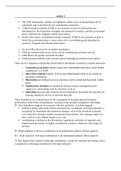Article 1
The VOC framework, varieties of capitalism, offers a way of measuring levels of
capitalism, and is divided into two institutional economies.
A liberal market economy (LME) is an economic system in which prices are
determined by the interaction of supply and demand in a market, and the government
plays a limited role. Supports radical innovations.
On the other hand, a coordinated market economy (CME) is an economic system in
which the government plays a more active role in coordinating and planning the
economy. Supports incremental innovations.
1. So, an LME relies heavily on market mechanism
2. CME government plays more active role in coordinating economic activity
3. LME allows for greater economic freedom
4. CME promotes stability and economic growth through government intervention.
There are five domains to determine which kind of institution's economy a country possesses.
1. Corporate governance implies legal rules, shareholder protection, stock market
valuation as % of GDP.
2. Inter-firm relations implies if firms can independently trade or are reliant on
governant institutions.
3. Hierarchies are defined as power structures, both vertical and horzontal, within
firms
4. Employment relations are defined by human resource management and
employees´ relationship with the firm they work at.
5. Education does not only stand for level of education, but mostly for specific job-
training employees receive to perform their job.
Three hypotheses are created based on the assumption of creating optimal economic
performance under these circumstances. resulting in the greatest comparative advantage.
H1: first hypothesis suggests an economy with low radicality. (Limited support)
radicality being radical innovations and decisions: an industry with high radicality is
recognized by immediate and enormous changes: such as the invention of steam).
Low radiciality therefore implies incremental innovations: slow changes made over
time; such as a new iPhone model every year.
coordination is defined as the allocation of operations and tasks by superiors and
employment protection. In highly coordinated countries, employees have high job
security.
H2: High radicality with low coordination in all institutional spheres (Partial support)
H3: High radicality with high coordination in all institutional spheres (Most support)
This implies that countries with high coordination, except for corporate governance, have
a comparative advantage in industries with high radicality.
, Article 2
The authors advanced a new framework that is based on the VOC framework and also the
NBS (National Business Systems) framework. They came up with their own framework,
called Varieties of Institutional Systems (VIS) because both NBS and VOC had their
limitations.
The limitations of VOC have you just heard, but the biggest one was only using developed
economies, most of which from Europe.
NBS is criticized for high levels of abstraction and the inclusion of elements that are hard to
measure.
Also, both of these frameworks focus on advanced economies and are not suited for emerging
and developing countries.
The new VIS framework is focusing on those developing, understudied countries in Africa,
Asia, the Middle East, East-Europe, and Latin America.
In the VIS framework they focus on five aspects: role of state, financial markets, human
capital, social capital and corporate governance institutions. Within those aspects, 13
institutional elements are presented, such as direct state dominance, family wealth,
knowledge capital, trust and family ownership. The biggest difference with the VOC and
NBS frameworks is that they now have considered family wealth and trust in a country to be
as important as the other aspects. And especially those two things are important to understand
those understudied countries.
So, from the archival data and the panel of experts, they formed 7 configurations. The
configurations basically serve the same purpose as the LME and CME from the VOC
framework, however, these are more extensive and detailed.
There is Configuration 1: state-led, a mix of countries with limited and wide civil liberties
and an active state role in the economy. There is often low trust in the government. This can
for example be China.
Conf 2: Fragmented with fragile style, often sub-sahara African and middle East countries,
with low financial, human and social capital, like Egypt.
Conf 3 is family-led, here wealthy and dominant families are the center in ownership and
management, like in Brazil.
Conf 4 is the Centralized Tribe, these are all middle eastern countries where powerful
families own key resources but also provide for the lower class people. Neither NBS nor
VOC resemble such a conf. Probably because neither of them observed these regions.
Conf 5, Emergent LME, is most like the LMEs from the VOC approach. There is high
knowledge and financial capital, like Hongkong.
Conf 6, collaborative agglomerations, are all eastern Europe countries. They kind of resemble
the CMEs from the VOC framework, however, these economies are often more focused on
growth and development than on equity.
Lastly, conf 7, hierarchical coordinated, which also resembles a little bit the CMEs. However,
here the state has more active control.
The reason these 7 configurations are a more manageable taxology than the VOC and NBS is
because these countries are relatively clustered which makes it easier to illustrate.





